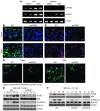Formylpeptide receptor-2 contributes to colonic epithelial homeostasis, inflammation, and tumorigenesis
- PMID: 23454745
- PMCID: PMC3613917
- DOI: 10.1172/JCI65569
Formylpeptide receptor-2 contributes to colonic epithelial homeostasis, inflammation, and tumorigenesis
Abstract
Commensal bacteria and their products provide beneficial effects to the mammalian gut by stimulating epithelial cell turnover and enhancing wound healing, without activating overt inflammation. We hypothesized that N-formylpeptide receptors, which bind bacterial N-formylpeptides and are expressed by intestinal epithelial cells, may contribute to these processes. Here we report that formylpeptide receptor-2 (FPR2), which we show is expressed on the apical and lateral membranes of colonic crypt epithelial cells, mediates N-formylpeptide-dependent epithelial cell proliferation and renewal. Colonic epithelial cells in FPR2-deficient mice displayed defects in commensal bacterium-dependent homeostasis as shown by the absence of responses to N-formylpeptide stimulation, shortened colonic crypts, reduced acute inflammatory responses to dextran sulfate sodium (DSS) challenge, delayed mucosal restoration after injury, and increased azoxymethane-induced tumorigenesis. These results indicate that FPR2 is critical in mediating homeostasis, inflammation, and epithelial repair processes in the colon.
Figures






References
Publication types
MeSH terms
Substances
Grants and funding
LinkOut - more resources
Full Text Sources
Other Literature Sources
Molecular Biology Databases

